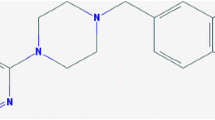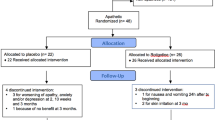Abstract
In addition to treating the motor symptoms of Parkinson’s disease, the dopamine agonist pramipexole has shown an antidepressant effect. The trials, however, included patients with motor complications, raising the question of whether the antidepressant benefit represented only a treatment–related motor improvement. To address this issue, we have conducted a 14–week randomized trial comparing pramipexole with an established antidepressant in patients without motor complications. At seven Italian centers, 67 Parkinsonian outpatients with major depression but no history of motor fluctuations and/or dyskinesia received open–label pramipexole (at 1.5 to 4.5 mg/day) or sertraline (at 50 mg/day). In both groups, the Hamilton Depression Rating Scale (HAM–D) score decreased throughout 12 weeks of treatment, but in the pramipexole group the proportion of patients who recovered, as defined by a final HAM–D score ≤ 8,was significantly higher, at 60.6% versus 27.3% (p = 0.006). Patients’ self–ratings improved in both groups. All adverse events were mild or moderate, but five patients (14.7%) withdrew from the sertraline group. Despite the absence of motor complications, the pramipexole recipients showed improvement on the Unified Parkinson’s Disease Rating Scale (UPDRS) motor subscore. We conclude that dopamine agonists may be an alternative to antidepressants in Parkinson’s disease.
Similar content being viewed by others
References
American Psychiatric Association (1994) Diagnostic and Statistical Manual of Mental Disorders, 4th Edition. APA Press, Washington, DC
Ceravolo R, Nutti A, Piccinni A, Dell’Agnello G, Bellini G, et al. (2000) Paroxetine in Parkinson’s disease: effects on motor and depressive symptoms. Neurology 55:1216–1218
Corrigan MH, Denahan AQ, Wright CE, et al. (2000) Comparison of pramipexole, fluoxetine and placebo in patients with major depression. Depression Anxiety 11:58–65
de la Fuente–Fernandez R, Schulzer M, Stoessl AJ (2002) The placebo effect in neurological disorders. Lancet Neurol 1:85–91
Dell’Agnello G, Ceravolo R, Nuti A, Bellini G, Piccinni A, D’Avino C, Dell’Osso L, Bonuccelli U (2001) SSRIs do not worsen Parkinson’s disease: evidence from an open–label, prospective study. Clin Neuropharmacol 24: 221–227
Fahn S, Elton R, and Members of the UPDRS Development Committee (1987) Unified Parkinson’s Disease Rating Scale. In: Fahn S, Marsden CD, Goldstein M, Calne DB (eds) Recent developments in Parkinson’s Disease, vol 2. :Macmillan, New York, pp 153–163
Gibb WR, Lees AJ (1988) The relevance of Lewy body to the pathogenesis of idiopathic Parkinson’s disease. J Neurol Neurosurg Psychiatry 51:745–752
Global Parkinson’s Disease Survey Steering Committee (2002) Factors impacting on quality of life in Parkinson’s disease: results from an international study. Mov Disord 17:60–67
Goldberg JF, Burdick KE, Endick CJ (2004) Preliminary randomized, double–blind, placebo–controlled trial of pramipexole added to mood stabilizers for treatment–resistant bipolar depression. Am J Psychiatry 161:564–566
Hamilton M (1960) A rating scale for depression. J Neurol Neurosurg Psychiatry 23:56–62
Hauser RA, Zesiewicz TA (1997) Sertraline for the treatment of depression in Parkinson’s disease. Mov Disord 12:756–859
Hoehn MM, Yahr MD (1967) Parkinsonism: onset, progression, and mortality. Neurology 17:427–442
Jenner P (2003) Dopamine agonists, receptor selectivity and dyskinesia induction in Parkinson’s disease. Curr Opin Neurol 16(Suppl 1):S3–S7
Lemke MR, Brecht HM, Koester J, Kraus PH, Reichmann H (2005) Anhedonia, depression, and motor functioning in Parkinson’s disease during treatment with pramipexole. J Neuropsychiatry Clin Neurosci 17:214–220
Lieberman A, Ranholsky A, Kots D (1997) Clinical evaluation of pramipexole in advanced Parkinson’s disease: results of a double–blind, placebo–controlled, parallel–group study. Neurology 49:162–168
Menza MA, Sage J, Marshall E, Cody R, Duvoisin R (1990) Mood changes and “on–off” phenomena in Parkinson’s disease. Mov Disord 5:148–151
Parkinson Study Group (2000) Pramipexole vs levodopa as initial treatment for Parkinson disease: A randomized controlled trial. Parkinson Study Group. JAMA 284:1931–1938
Racette BA, Hartlein JM, Hershey T, Mink JW, Perlmutter JS, Black KJ (2002) Clinical features and comorbidity of mood fluctuations in Parkinson’s disease. J Neuropsychiatry Clin Neurosci 14:438–442
Rektorova I, Rektor I, Bares M, Dostal V, Ehler E, Fanfrdlova, Fiedler J, Klajblova H, Kulistak P, Ressner P, Svatova J, Urbaanek K, Veliskova J (2003) Pramipexole and pergolide in the treatment of depression in Parkinson’s disease: a national multicentre prospective randomized study. Eur J Neurol 10:399–406
Renard CE, Fiocco AJ, Clenet F, Hascoet M, Bourin M (2001) Is dopamine implicated in the antidepressant– like effects of selective serotonin reuptake inhibitors in the mouse forced swimming test? Psychopharmacology 159:42–50
Richard IH, Maughn A, Kurlan R (1999) Do serotonin reuptake inhibitor antidepressants worsen Parkinson’s disease? A retrospective case series. Mov Disord 14:155–193
Shannon KM, Bennett JP, Friedman JH (1997) Efficacy of pramipexole, a novel dopamine agonist, as monotherapy in mild to moderate Parkinson’s disease. Neurology 49:724–728
Szegedi A, Hillert A Wetzel H, et al. (1997) Pramipexole, a dopamine agonist, in major depression: antidepressant effects and tolerability in an open–label study with multiple doses. Clin Neuropharmacol 20:36–45
Tesei S, Antonini A, Canesi M, Zecchinelli A, Mariani CB, Pezzoli G (2000) Tolerability of paroxetine in Parkinson’s disease: a prospective study. Mov Disord 15:986–989
Ware JE, Sherbourne CD (1992) The MOS 36–item short–form general health survey (SF–36), I: conceptual framework and item selection. Med Care 30:473–483
Weintraub D, Morales KH, Moberg PJ, Bilker WB, Balderston C, Duda JE, Katz IR, Stern MB (2005) Antidepressant studies in Parkinson’s disease: A review and meta–analysis. Mov Disord 20:1161–1169
Zarate CA Jr, Payne JL, Singh J, Quiroz JA, Luckenbaugh DA, Denicoff KD, Charney DS, Manji HK (2004) Pramipexole for bipolar II depression: a placebo–controlled proof of concept study. Biol Psychiatry 56:54–60
Zung WWK (1965) A self–rating depression scale. Arch Gen Psychiatry 12:63–70
Author information
Authors and Affiliations
Consortia
Corresponding author
Additional information
Members of the Depression/Parkinson Italian Study Group: M.T. Pellecchia, M. Amboni, Dipartimento di Scienze Neurologiche, Università di Napoli Federico II, Italy; A. Schiatti, SOC di Neurologia, Ospedale Evangelico Valdese, Torino, Italy; Sadia Carapelli, Dipartimento di Neuroscienze, Ospedale Misericordia, Grosseto, Italy; G. Pezzoli, S. Tesei, Centro Parkinson, Istituti Clinici di Perfezionamento, Milano, Italy; A. Epifanio, Dipartimento di Neuroscienze, Scienze Psichiatriche ed Anestesiologiche, Università di Messina, Italy; E. Gasparoli, Dipartimento di Scienze Neurologiche e Psichiatria, Università di Padova, Italy; G. Arabia, Dipartimento di Neuroscienze, Università di Catania, Italy; M. G. Papini, A. Battaglia, Medical Department, Pharmacia Co, Milano, Italy.
Rights and permissions
About this article
Cite this article
Barone, P., Scarzella, L., Marconi, R. et al. Pramipexole versus sertraline in the treatment of depression in Parkinson’s disease. J Neurol 253, 601–607 (2006). https://doi.org/10.1007/s00415-006-0067-5
Received:
Revised:
Accepted:
Published:
Issue Date:
DOI: https://doi.org/10.1007/s00415-006-0067-5




